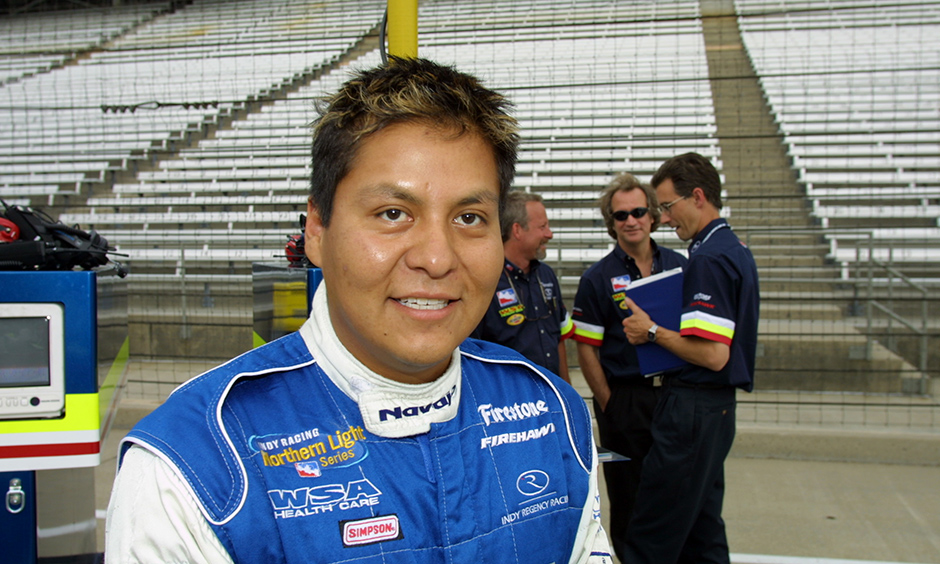Witherill Remains Proud of Making Indy 500 History in 2001
NOV 26, 2021
Cory Witherill owns the G-Force chassis that he and Indy Regency Racing used to qualify for his only Indianapolis 500 start, in 2001. The car sits in a Columbus, Ohio, shop with a paint scheme different than its racing colors. Witherill would like to give it a retro look as part of a larger plan.
That day in May 2001, Witherill became the first – and still only – full-blooded Native American driver to qualify for the “500.” Now 20 years in the rear-view mirror, Los Angeles native Witherill still hopes that achievement can inspire others.
One idea is to showcase the car in its Indy livery at either the Navajo Nation Museum in Window Rock, Arizona, or the Eiteljorg Museum of American Indians and Western Art in Indianapolis. Presenting it in November, which is National Native American Heritage Month, would be a bonus.
“It’s still complete,” Witherill said of what was then the No. 16 car. “I was using it as a show car for my kids’ program back in the day with Hemelgarn (Racing), so it painted purple and white No. 92, Hemelgarn colors.”
 Qualifying for the “500” continues to be the most-celebrated moment in Witherill’s motorsports career. Photographs hanging in his garage in Redondo Beach, California, are reminders of how an Indy Lights team earned a place in the most prestigious of INDYCAR SERIES fields.
Qualifying for the “500” continues to be the most-celebrated moment in Witherill’s motorsports career. Photographs hanging in his garage in Redondo Beach, California, are reminders of how an Indy Lights team earned a place in the most prestigious of INDYCAR SERIES fields.
Witherill was a product of motocross and off-road racing, building an open-wheel career through various lower divisions before joining CART’s Indy Lights series in 1998. He was 29, with only one Indy Racing League start, that coming less than a month prior to the “500” at Atlanta Motor Speedway when he was collected in the large Turn 4 accident early in the race.
Witherill’s heritage drew a fair amount of attention at Indianapolis Motor Speedway, but he was focused on earning a starting position. Finally, at 5:02 p.m. on Bump Day, with an Oldsmobile engine provided by John Menard, Witherill rolled off for what became a four-lap run averaging 221.621 mph, good for the inside of Row 11.
Witherill credited two-time “500” winner Arie Luyendyk, whose garage was next to his, for offering advice and answering the questions of a rookie. Indy Regency had competed in several “500s” and was led by Sal Incandela, a former Formula One mechanic who was part of two Grand Prix World Championships (James Hunt in 1976 and Nelson Piquet in 1983). But it was the engine offered by Menard that likely was the difference in the team making the race.
“What stands out (about qualifying)? Pretty much everything,” said Witherill, who became the last Indy Regency driver to compete at Indy. “I don’t know if it’s different than anyone else: It’s being there and knowing the whole history of the ‘500’ and being part of it.
“I always knew I could qualify for it, but when you’re an Indy Lights team and you show up for the biggest race in the world with one car and you’re under-budgeted, you’re at a disadvantage.”
Witherill completed 187 laps in the 86th Running, finishing 19th. He said his “500” run often comes up in conversation with friends, although while neighbors on either side of him didn’t know of his Indy accomplishment despite each having attending the race years ago and being INDYCAR SERIES fans.
Interestingly, a trophy won in the 2003 Infiniti Pro Series generally gets people talking about Witherill’s racing past. Hanging in the living room of his Southern California home is a custom-made Gibson guitar he received for winning that year’s race at Nashville Superspeedway.
“People see it and say, ‘You play the guitar?’” he said, laughing. “I’m like, ‘No, I don’t,’ but it makes for good conversation. I explain it by saying next to the Borg-Warner Trophy, it’s probably the trophy all of the drivers wanted to win back then. We all wanted to win at Nashville.”
While qualifying at Indy remains the signature moment of Witherill’s career, he said the inaugural Freedom 100 in 2003 at IMS ranks near the top of his highlights. Ed Carpenter, then 22 and a week removed from college graduation, dominated the race, winning by nearly 14 seconds, but Witherill, Mark Taylor and Jeff Simmons spent much of the race in a fierce battle for second. Witherill had the position at the finish.
“I remember we were going down the front straightaway (beginning Lap 28), and I had a good run on Simmons,” Witherill said. “He was trying to go around the outside of Taylor, and I tried to go to the inside of Taylor.
“All of a sudden we were going three-wide in Turn 1. I was hoping (the tires) would stick, and I thought, ‘I don’t want to be the one on the outside.’ But we all got around (the corner).”
Witherill and Taylor had an even closer moment in Turn 3 a few laps later.
Combining Indy Lights and the Infiniti Pro Series, Witherill made 54 starts over seven seasons, winning once and finishing second four times. He also made the occasional ARCA and ASA starts in stock cars before stepping away from competitive racing following the 2004 season.
Witherill, who turns 50 next month and works in real estate, has returned to IMS a few times over the years, mostly for a pair of Sportscar Vintage Racing Association events and “500” Legends Day autographs sessions for former drivers. He is hopeful the end of the pandemic allows for a proper annual celebration of Indy’s past next May.
In 2001, Witherill earned his place in that history.






















